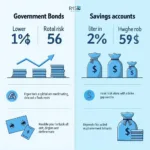Market trends show that questions about personal finance and economic decisions appear in approximately 15% of recent IELTS Writing Task 2 exams. The topic of refinancing during low-interest periods has emerged multiple times, particularly in tests administered across Asian test centers. Based on analysis of past papers, here’s a relevant question that has appeared:
Some people believe that individuals should refinance their loans when interest rates are low, while others think it’s better to maintain existing loan terms regardless of market conditions. Discuss both views and give your opinion.
Analysis of the Question
- Topic: Personal finance decisions regarding loan refinancing
- Task: Discussion + opinion
- Key areas to cover: Benefits and drawbacks of refinancing, circumstances when maintaining existing loans may be preferable
- Scope: Economic and personal financial implications
 Understanding loan refinancing decisions in different economic conditions
Understanding loan refinancing decisions in different economic conditions
Band 8-9 Sample Essay
During periods of economic fluctuation, the decision to refinance existing loans presents individuals with a complex financial choice. While some advocate for taking advantage of lower interest rates through refinancing, others prefer maintaining their original loan arrangements. In my opinion, strategic refinancing during low-rate periods often provides significant financial benefits, though this decision requires careful consideration of individual circumstances.
The primary argument for refinancing when rates drop centers on potential cost savings. When interest rates decrease substantially, borrowers can reduce their monthly payments and overall loan costs by restructuring their debt at lower rates. For instance, a homeowner with a 6% mortgage could save thousands of dollars annually by refinancing at 4%, allowing for increased disposable income or accelerated loan repayment. Additionally, refinancing can provide opportunities to consolidate multiple loans or modify loan terms to better align with current financial goals.
However, proponents of maintaining existing loans present valid counterarguments. The refinancing process often involves significant upfront costs, including application fees, valuation charges, and legal expenses. These expenses might outweigh potential savings, particularly for those planning to sell their assets or repay loans in the near term. Furthermore, extending loan terms through refinancing could result in paying more interest over time, despite lower monthly payments.
From my perspective, the decision to refinance should be based on a thorough cost-benefit analysis. Borrowers should calculate their break-even point, considering both immediate expenses and long-term savings. For example, if refinancing costs $3,000 but saves $200 monthly, the break-even period would be 15 months. Those planning to maintain their loans beyond this period would benefit from refinancing, while others might not.
Band 6-7 Sample Essay
Many people debate whether it’s good to refinance loans when interest rates go down or keep their original loans. This essay will discuss both sides and share my thoughts on this important financial decision.
People who support refinancing when rates are low have some good reasons. First, lower interest rates mean lower monthly payments, which helps save money. For example, if someone has a home loan at 7% interest and can get a new loan at 5%, they can save money every month. Also, some people use refinancing to combine different loans into one payment, which is easier to manage.
On the other hand, keeping the original loan also has advantages. The main problem with refinancing is that it costs money at the beginning. Banks charge fees for new loans, and sometimes these fees are very high. Also, some people worry about the paperwork and time needed to refinance. They think it’s better to stay with what they know.
In my opinion, refinancing can be good but only if people think carefully about their situation. They should look at how much money they can save and how long they will keep the loan. If someone plans to sell their house soon, refinancing might not be worth it. But if they plan to keep their loan for many years, the savings from lower interest rates could be very helpful.
Key Vocabulary
- Refinancing (n) /riːˈfaɪnænsɪŋ/ – the process of replacing an existing loan with a new one
- Break-even point (n) /breɪk-ˈiːvən pɔɪnt/ – the point at which gains equal losses
- Consolidate (v) /kənˈsɒlɪdeɪt/ – combine several loans into one
- Disposable income (n) /dɪˈspəʊzəbl ˈɪnkʌm/ – money available for spending after taxes
- Upfront costs (n) /ˈʌpfrʌnt kɒsts/ – initial expenses that must be paid
- Valuation (n) /væljuˈeɪʃn/ – professional assessment of an asset’s worth
- Cost-benefit analysis (n) /kɒst-ˈbenɪfɪt əˈnælәsɪs/ – evaluation of pros and cons in financial terms
For practice, consider writing about this related topic:
“Some experts suggest that governments should regulate interest rates to protect borrowers. Others believe market forces should determine rates. Discuss both views and give your opinion.”
Share your practice essays in the comments below for feedback and discussion with other learners.


